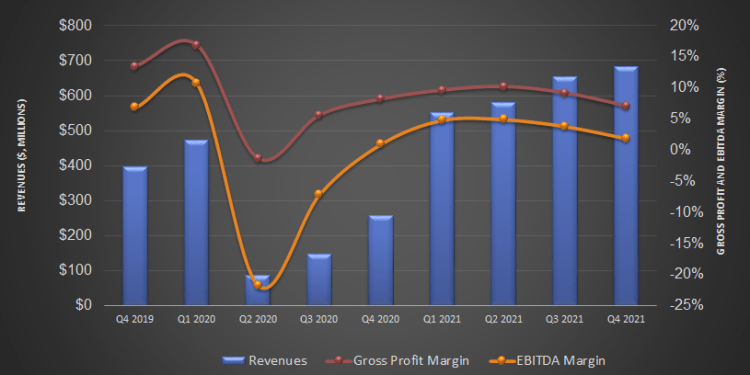- LBRT focuses on frac fleet upgrade and added revenues from PropX and OneStim fleets
- The plans to get have at least two complete digiFrac fleets in 2022
- However, supply chain challenges and rig upgrade costs issues will keep pressure on the margin in the near term
- Despite lower cash flows, the company’s low leverage ensures financial safety
Merger Benefits Are Into The Swing
Two acquisitions made significant changes to LBRT’s outlook in 2021. In October 2021, it acquired PropX, a long-time supplier of environmental-friendly last mile proppant delivery solutions. In January 2021, Liberty had acquired Schlumberger’s (SLB) OneStim – the onshore hydraulic fracturing business in the US and Canada. In the past year until now, revenue contribution from OneStim increased by 156% due to new basins addition and complementary sand and wireline businesses.
Following the PropX acquisition, the company benefited from optimization through its efficient software. The PropConnect real-time logistics software helped in significant improvement in route optimization. Liberty’s Wet sand handling will be helpful in the processing and delivery of sand in PropX’s function. This ESG-friendly solution removes the need to dry sand at the mine, thus lowering the emission level. PropX already has several contracts lined up in 2022 to support mini mines that lower the total delivery cost, eliminate the drying process, and reduce trucking needs.
Upgraded Frac Fleet
LBRT has been focusing on using Tier IV DGB and the digiFrac fleets. The Tier IV pumps are equipped with automated controls to maximize gas substitution that satisfies the lower emission standards. The repairs and maintenance for frac fleets are typically much lower than the traditional diesel fleets, which increases the profitability margin. It plans to have at least two complete digiFrac fleets operational in 2022.
However, LBRT did face an operational challenge in this regard. The OneStim fleets use maintenance systems different from the legacy set, which led to significant inefficiencies during integration. As a result, it recorded an effective integration-related cost in Q4 2021 ($2.8 million in startup laydown costs). The management is trying to bring such costs down in 2022 by introducing a virtual digital twin model for each frac pump.

According to Primary Vision’s forecast, the frac spread count (or FSC) reached 282 by the second week of March and has gone up by 16% since the start of 2022. Liberty’s FSC, which dropped significantly during mid-2020, has recovered steadily since. Year-over-year, it increased by 123% until January. However, it can face downward pressure in the short term as utilization and frac pricing per stage shot up rapidly. Due to supply chain disruption, the delays can also affect proppant deliveries and result in operators’ pull back.
The Industry And Outlook

The crude oil price steadied in Q4 but has soared since then following the Ukraine crisis and COVID normalization. The US rig count, which declined by 9% in Q4, has recovered fast in Q1. The drilled and completed well counts continue to strengthen in 2022 while the drilled-but-uncompleted (or DUC) have been coming down. By the start of 2022, many oilfield services companies, including Halliburton (HAL), Schlumberger (SLB), and Liberty, believe that an energy upcycle begun following years of underinvestment. The tightness in supply and the upstream operators’ logical response to the energy price rise mean supply will rise, albeit at a more moderate rate than expected. However, the supply side will factor in labor shortages, supply attrition, and a move towards the next generation frac fleet technologies.
In Q1 2022, LBRT expects to benefit from the increased pricing and the general improvement in the energy scenario. So, its revenues can increase by “high-single-digit.” Also, it is confident of passing through the inflationary costs and realizing higher net service pricing and frac pricing in subsequent quarters. Costs, too, can decrease due to lower integration-related costs. Although pricing remains below the pre-pandemic level, service pricing and utilization are increasing. So, Liberty, with its ESG-loaded solutions and top-tier emission fleets, is in a suitable position to benefit from this.
What Were LBRT’S Q4 Drivers?

LBRT’s topline improved in Q4 2021. From Q3 to Q4, its revenues went up by 5%. Despite the seasonal slowdown, it benefited from an uptick in business in every basin and a high-level efficiency. However, EBITDA decreased in Q4 due to higher integration-related costs following the OneStim acquisition. The integration costs, including the elevated parts replacements, reduced margins by over 200 basis points. The company expects the cost level to fall, expanding the EBITDA margin in Q1.
In Q4, the company’s net loss deteriorated to $57 million from $39 million in Q3. Approximately $7.6 million of non-recurring expenses, including Fleet Startup laydown costs and severance and other costs, led to a steeper net loss.
Cash Flows And Debt
LBRT’s cash flow from operations (or CFO) increased by 59% in FY2021 compared to a year earlier due to higher revenues. Capex increased even more sharply (92% up) during this period, leading to a free cash flow (or FCF) deterioration. Its FCF has stayed negative in the past several quarters.
In FY2021, it spent 20% of its gross capex on Tier IV DGB upgrade and digiFrac technology. In FY2022, its capex is projected to increase by 63% (at the guidance mid-point). It will continue to invest in digiFrac pad generation systems, and Tier IV DGB upgrades with sand handling technology. Despite the capex budget rise, it expects to turn free cash flow positive in 2022 through margin improvement. As of December 31, 2021, LBRT’s liquidity amounted to $269 million. The company’s debt-to-equity (0.10x) is significantly lower than many of its peers in the fracking services industry.
Learn about LBRT’s revenue and EBITDA estimates, relative valuation, and target price in Part 2 of the article.













